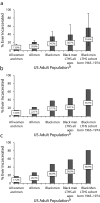Measuring Correctional Experience to Inform Development of HIV, Sexually Transmitted Infection, and Substance Use Interventions for Incarcerated Black Men Who Have Sex with Men
- PMID: 30383418
- PMCID: PMC6215376
- DOI: 10.2105/AJPH.2018.304810
Measuring Correctional Experience to Inform Development of HIV, Sexually Transmitted Infection, and Substance Use Interventions for Incarcerated Black Men Who Have Sex with Men
Figures

Comment on
-
HIV, Sexually Transmitted Infection, and Substance Use Continuum of Care Interventions Among Criminal Justice-Involved Black Men Who Have Sex With Men: A Systematic Review.Am J Public Health. 2018 Nov;108(S4):e1-e9. doi: 10.2105/AJPH.2018.304698. Am J Public Health. 2018. PMID: 30383433 Free PMC article.
References
-
- Western B, Pettit B. Incarceration and social inequality. Daedalus. 2010;139(3):8–19. - PubMed
-
- Davis JA, Smith TW. The NORC General Social Survey: A User’s Guide. Vol 1. Thousand Oaks, CA: SAGE publications; 1991.
-
- Roman CG, Travis J. Where will I sleep tomorrow? Housing, homelessness, and the returning prisoner. Hous Policy Debate. 2006;17(2):389–418.
-
- Kreider RM, Ellis R. Number, timing, and duration of marriages and divorces, 2009. US Dept. of Commerce, Economics and Statistics Administration, US Census Bureau 2011. Available at: https://www.census.gov/prod/2011pubs/p70-125.pdf. Accessed 6 August 2016.
Publication types
MeSH terms
Grants and funding
LinkOut - more resources
Full Text Sources
Medical

